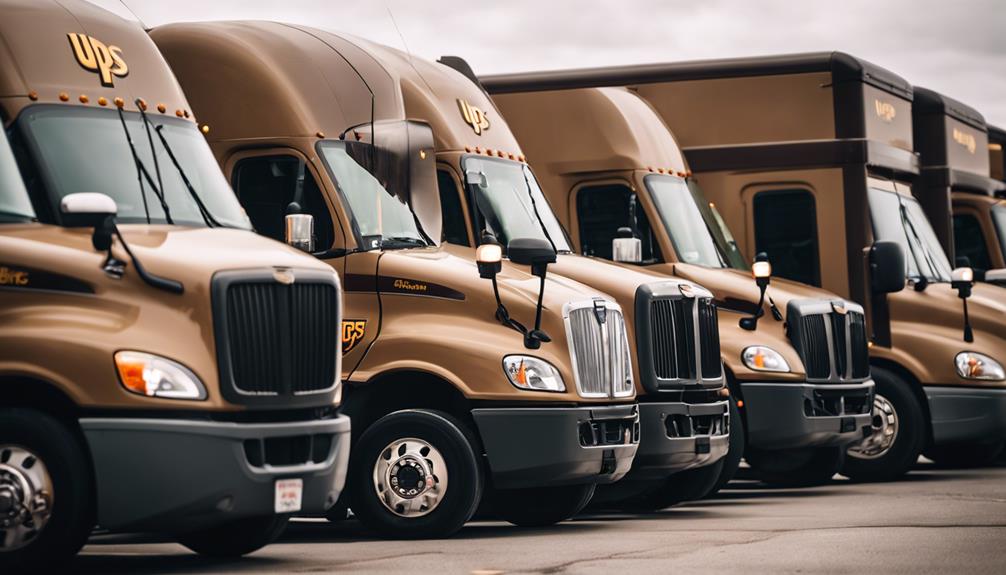The typical height of UPS trucks stands at around 9 feet 6 inches, strategically crafted for ideal cargo space and regulatory compliance. Various models and configurations may exhibit slight height variations to cater to specific operational needs. Ensuring proper height adherence is essential for safety, preventing accidents, damages, and legal issues, all meticulously monitored through rigorous safety inspections and innovative technologies. Urban settings present unique challenges that demand height enhancement for efficient maneuverability and timely deliveries, showcasing the intricate balance between design, functionality, and technological advancements in UPS truck operations.
Key Takeaways
- Average height of UPS trucks is approximately 9 feet 6 inches.
- Height compliance is crucial for safety and regulatory adherence.
- Specific vehicle configurations and models influence truck height.
- UPS trucks are designed for optimal cargo space and height balance.
UPS Truck Height Overview

The height of UPS trucks, averaging approximately 9 feet 6 inches, plays an essential role in ensuring ideal navigation in urban areas and accommodating large packages and parcels. UPS truck design is meticulously crafted to optimize cargo space while adhering to height restrictions for safe transit.
The average weight of a UPS truck, around 12,000 pounds, underscores the importance of a robust design to support the load capacity efficiently. Variability in height exists based on specific truck models and configurations, allowing for customized solutions to suit diverse operational needs.
Ensuring compliance with height regulations is vital to prevent accidents and damage to both the vehicle and surrounding infrastructure. UPS trucks strike a balance between height, cargo space, and design to deliver packages efficiently and safely.
Importance of Height Compliance
Height compliance is a critical aspect of UPS truck operations, guaranteeing safety, regulatory adherence, and infrastructure preservation.
Adhering to height regulations is paramount in urban planning to prevent accidents, protect overhead structures, and maintain efficient traffic flow. Non-compliance with height restrictions can lead to fines, penalties, and legal complications.
Regular safety inspections are essential to guarantee that UPS trucks meet the required height standards for road clearance. By checking truck height against posted clearances before travel, drivers mitigate risks associated with low-hanging obstacles and overpasses.
Height regulations play an essential role in guaranteeing truck size and safety compliance, safeguarding both the vehicle and the surrounding infrastructure from potential damage.
Factors Influencing Truck Height

UPS truck height variations are primarily influenced by the specific vehicle configurations and models utilized.
Different truck types and designs are tailored to meet distinct operational needs, leading to height discrepancies among UPS vehicles.
The purpose of the truck, such as urban package delivery or off-road transportation, plays an essential role in determining the ideal height for efficient functionality.
Additionally, specialized modifications and enhancements aimed at increasing cargo capacity and improving navigability can also impact the overall height of UPS trucks.
Consequently, variations in truck height are a result of the intricate interplay between vehicle design, operational requirements, and technological advancements in the logistics industry.
Height-Enhancing Features and Equipment
Variations in UPS truck height are often influenced by the incorporation of specialized features and equipment designed to enhance the vehicle's height for superior operational performance.
Height-enhancing modifications play an important role in optimizing cargo capacity improvements and overall efficiency.
UPS trucks come equipped with advanced technological features such as AVT systems, telematics, and GPS for real-time monitoring and route optimization.
Specialized compartments are tailored for fragile and perishable items, while state-of-the-art scanning technology aids in package sorting.
These enhancements not only improve reliability and efficiency but also guarantee the secure transport of packages.
Such innovative features are essential for meeting the dynamic demands of the logistics industry while maintaining high standards of service delivery.
Safety Measures for Height Navigation

Considering the complexities of urban environments and the need for efficient delivery operations, implementing robust safety measures for maneuvering the height of UPS trucks is paramount.
Driver training plays an essential role in height navigation, ensuring awareness of bridge clearances, overpass restrictions, and low-hanging obstacles to prevent accidents and damage.
Regular safety inspections are essential to maintain compliance with height regulations, emphasizing the importance of checking truck height against posted clearances before travel.
Adherence to height restrictions is fundamental for accident prevention and infrastructure protection. Non-compliance can lead to fines, penalties, and legal issues, underscoring the significance of prioritizing safety measures in UPS truck operations.
Height Optimization for Urban Deliveries
In the context of urban delivery operations, optimizing the height of UPS trucks is imperative to guarantee efficient maneuvering and successful package drop-offs.
Urban delivery challenges often involve navigating through narrow streets, low-clearance bridges, and congested areas, emphasizing the significance of height adaptation strategies.
UPS employs height optimization by designing trucks with adjustable air suspension systems that allow for height adjustments based on the specific delivery requirements of urban areas.
Additionally, the incorporation of rooftop sensors and warning systems assists drivers in avoiding height-related obstacles.
These height adaptation strategies not only enhance maneuverability in urban settings but also contribute to the overall safety and efficiency of UPS truck operations, ensuring timely and secure package deliveries.
Advanced Technology in UPS Trucks

The integration of advanced technology in UPS trucks enhances operational efficiency and delivery precision through innovative features and systems.
UPS trucks are equipped with sophisticated telemetry systems that provide real-time data on vehicle performance, route optimization, and driver behavior. These systems enable fleet managers to monitor fuel consumption, vehicle diagnostics, and maintenance schedules, leading to cost savings and improved productivity.
Additionally, UPS trucks utilize advanced package tracking technology, allowing customers to track their shipments accurately from pickup to delivery.
The implementation of these cutting-edge technologies guarantees that UPS maintains its reputation for reliable and timely deliveries while adapting to the evolving demands of the logistics industry.
Conclusion
In summary, the height of UPS trucks plays an essential role in ensuring operational efficiency and safety in the transportation and logistics industry.
With an average height of approximately 9 feet, these vehicles are designed to navigate various delivery environments while adhering to height regulations.
One interesting statistic to note is that UPS trucks can carry up to 700 packages at a time, showcasing the impressive capacity and capabilities of these vehicles in the fast-paced world of package delivery.

Oliver Postman was born and raised in a small town in the Midwest, where his fascination with postage began at an early age. At just six years old, he stumbled upon a box of old stamps in his grandfather’s attic, igniting a passion that would shape his life.

